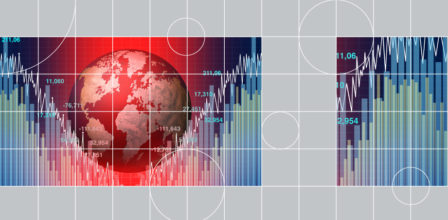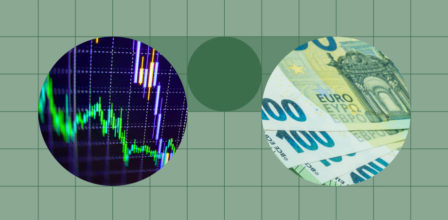Market commentary bonds: Have credit events ended the central bank rate hike cycle?
The market has been oscillating between recession and inflation concerns for several quarters. With the banking crisis in March 2023, the trend is clearly moving towards recession. This is also reflected in the interest rate expectations of market participants. Investors can tilt their portfolios towards this scenario.


Dr. Harald Henke
Head of Fixed Income Strategy
Current macro environment
The year 2023 began on the macro side in a friendly manner regarding inflation, growth and the labour market. The USA in particular initially proved to be very robust:
- Inflation in the US fell from 7.1% in November (published in mid-December) to 6.0% in February (published in mid-March).
- In Germany, inflation fell from 8.1% in December to 7.4% in March after an increase at the beginning of the year.
- Economic growth for the US was an annualised 2.6% in Q4 2022, down from 3.2% in Q3.
- The German economy fell by 0.4% in Q4 compared to the previous quarter; here a decline in private spending and business investment were the main factors.
- The US unemployment rate initially continued to fall, but then rose slightly towards the end of the quarter and was last measured at 3.6%, unchanged at a historically very low level.
- The German unemployment rate rose slightly to 5.6%, 0.6 percentage points higher than a year ago.
Overall, the macro environment remained friendly, but was no longer the focus of attention.
Credit events: Banking crisis
The focus was on the global banking system, which experienced its worst crisis since the financial crisis of 2008/09. It all started in March with the bankruptcy of Silicon Valley Bank (SIVB). The bank had enormous hidden losses on its balance sheet due to last year’s rise in interest rates. After a critical report by the rating agency Moody’s, SIVB tried to increase its capital, but the failed to accomplish it. Since the bank had many large deposits that were not covered by deposit insurance, this news triggered a flight of depositors, which led to the bank’s collapse.
When the closure of another bank, Signature Bank, was announced by the US regulator the following weekend, a new banking crisis had started. Many small and medium-sized US banks experienced the withdrawal of deposits and rating actions by the major rating agencies. For example, the share price of First Republic Bank plunged by more than 90% from the beginning of February to the end of March, while the rating agencies Moody’s and S&P each downgraded the bank’s rating by 7 notches to now B2/B+.
The panic continued on the other side of the Atlantic at the major Swiss bank Credit Suisse. Although Credit Suisse did not have write offs like the US banks, its name had been tarnished by numerous scandals and fines over the past years. When, in the course of the crisis, confidence in the bank was lost and other banks stopped transactions with Credit Suisse, the only option left for the Swiss regulator was a forced merger with UBS, taking over loss guarantees and providing generous liquidity lines for UBS.
Towards the end of the month, investors in the market then tested other banks, first and foremost Deutsche Bank, but here the attempt did not catch and there was a noticeable recovery rally at the end of the month.
How have the central banks reacted to this?
The Fed responded to the banking crisis and the bankruptcies of SIVB and Signature Bank in two ways. First, it issued an unlimited guarantee for deposits at these banks. Since both banks had many large depositors who feared substantial losses, this step was intended to restore confidence in US banks. The cost of this will be borne by the banking system as a whole.
On the other hand, a new liquidity instrument, the Bank Term Funding Program (BTFP), was launched to support banks in liquidity difficulties. Banks can take out loans of up to one year against collateral that is valued at par by the Fed. In this way, banks can avoid the realisation of hidden losses on the asset side of the balance sheet.
“With the guarantees, however, the Fed finds itself in a dilemma, since this measure, as sensible as it may have been in the short term, opens the door to moral hazard.”

Dr Harald Henke
Head of Fixed Income Strategy
With the guarantees, however, the Fed finds itself in a dilemma, since this measure, as sensible as it may have been in the short term, opens the door to moral hazard. Risky behaviour is rewarded because the profits can be collected by the respective bank, while losses are socialised. When Treasury Secretary Yellen tried to counteract this by pointing out that the decision was not a barometer for future cases, this in turn triggered significant price losses for banks.
In addition, the BTFP has brought a (temporary) end to the Fed’s Quantitative Tightening (QT) programme. While the volume of the Fed’s balance sheet has been declining since April last year, the new programme has driven up the Fed’s balance sheet total, as figure 1 shows.
Figure 1: Total assets of the Federal Reserve
The first attempt to reduce the balance sheet in 2019 was aborted after a good year and a half when there was turbulence in the financial system. In the current second QT attempt, which was accompanied this time by sharply rising interest rates, it took just under a year before there were major distortions in the market and the Fed was forced to counteract with liquidity. Accordingly, the central bank balance sheet recently rose again significantly from USD 8.35 trillion to USD 8.7 trillion.
In Europe, the Swiss National Bank (SNB) is involved in the rescue of Credit Suisse, as it is providing UBS with a liquidity line of up to CHF 200 billion. The central bank, which last year posted a loss of CHF 132 billion, had total assets of roughly CHF 880 billion at the end of December 2022.
What does the market expect?
The market reacted to the events with expectations of an imminent recession in Europe and the USA. Problems in the financial sector often lead to stricter credit standards and less lending to businesses. This then has a negative impact on general economic activity, but especially on small businesses.
This expectation was most evident in the two-year interest rate range. Figure 2 shows the two-year interest rate for government bonds from Germany and the USA in Q1/2023.
Figure 2: Two-year interest rates
German two-year rates peaked a full percentage point lower from the monthly high, while US rates peaked 1.3 percentage points lower. Such a move in short-term interest rates prices in massive and relatively short-term rate cuts by central banks. These, in turn, are only likely to occur if there is a sharp economic downturn.
Market participants’ expectations of future central bank policy changed accordingly. While stronger interest rate increases were continuously priced in until the outbreak of the banking crisis at the beginning of March, this expectation was significantly reduced with the onset of the crisis, as figure 3 shows.
Figure 3: Implied money market rates
At the beginning of March, the market still expected US key interest rates to climb three steps to 5.75% by June and remain there until the end of the year. Now only one step to 5.25% is expected, while interest rates are expected to fall 75 basis points thereafter to 4.5% by the end of the year. And while three interest rate steps down to 5% by June 2024 were already priced in, the market continues to expect them from a lower starting level. Thus, a key interest rate of approx. 3.75% is currently expected in June 2024 and 3.5% in December 2024.
These expectations thus reflect seven interest rate cuts between summer 2023 and winter 2024. One can clearly see that market participants fear that the problems in the banking sector will escalate into a significant economic slowdown. This is accompanied by a decline in inflation expectations. The two-year break-even inflation rate, an indicator of short-term inflation expectations, fell back to 2.7% at the end of the month, after climbing to 3.4% this year by early March.
Credit spread moves point to critical sectors
Also interesting was the movement of credit spreads in March, which not only gave up their positive development of the first two months, but also indicated which sectors the market sees as the most critical.
Figure 4: Credit spread changes
In the USD IG sector, spreads rose the most in March in the real estate (+52 bp) and banking (+40 to +45 bp) sectors. These sectors are thus significantly wider since the beginning of the year. In Euro terms, however, banks held up much better (+25 bp), while the real estate sector (+72 bp) underperformed more than other sectors. Since the beginning of the year, however, the spreads of these sectors have risen less than in USD due to the strong rally in the first two months of 2023.
The underperformance of the real estate sector shows that the market sees this area as one of the possible epicentres of the coming recession. After many years of price increases and growing loan volumes, sharply higher interest rates and potentially tighter bank lending are weighing on demand and sentiment in the sector.
Outlook
The Fed has raised interest rates from 0% to 5% within a year. How many projects in companies, how many companies themselves, that were profitable at 0% interest rates are now profitable at the current level? No one knows the answer to this question, but the events in the US banking system in March showed how quickly problems can come to light. A recession remains the most likely scenario.
The market has priced in an interest rate scenario that expects noticeable rate cuts. In the event of a strong recession, however, significantly larger interest rate cuts in the USA are conceivable. On the other hand, if a recession is still to come and inflation remains high for the time being, the opposite scenario is also conceivable, with interest rate cuts being temporarily priced out again. In any case, we can assume that the interest rate market will continue to fluctuate wildly.
The market movement in March has shown where the market sees trouble spots in the current economic environment. Besides banks and financial service providers, especially in the USA, the real estate market is at the centre of concerns. Market participants can therefore use a temporary calm to weatherproof their portfolios for more turbulent times by reducing risk and selling names most impacted in a recession. Who knows how many more such opportunities will present themselves?


